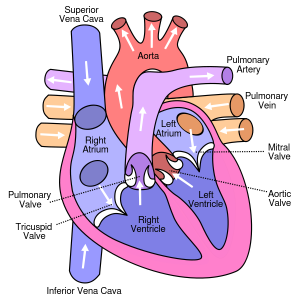By Kelsey Gray
Hearts have long been associated with the month of February. Hallmark Cards began producing Valentine’s Day cards featuring the heart in the early 1900s. The first American Heart Month was declared by President Lyndon B. Johnson and took place in February 1964. In 2003, the first National Wear Red Day was held in February and has been observed on the first Friday in February every year since. If you were thinking, “Wow, hearts seem to be really important!” you would be correct.
The heart is a muscle that pumps blood throughout the body to provide nutrients to, and remove waste from, all of the parts of the body. This process is essential to human life, but there are several ways it can go wrong. Congenital heart defects are abnormalities in the structure of the heart that are present when a person is born. Problems with the heart can also occur later in life and this is called “heart disease” or “cardiovascular disease.” Fortunately, there are several ways to fix or prevent these problems.
Your heart is a special kind of muscle, called an involuntary muscle, that is always working even when you don’t think about it. This is different than moving your arm or your leg, which is a voluntary action. Your heart keeps beating, day and night, no matter what you are doing.

Your heart has four different compartments called chambers. The two chambers at the top of the heart are called atria (each individual chamber is an atrium) and the two chambers at the bottom are called ventricles. The right side of your heart receives blood that has already gone through the body and sends it to the lungs to pick up oxygen. The left side of your heart gets freshly oxygenated blood from the lungs and sends it out to the rest of the body. A muscular wall called the septum separates the two sides of the heart.
One common congenital heart defect, present in up to 25 percent of the general population, occurs due to an opening in the septum between the left and right atrial chambers of the heart. Babies have this opening before they are born, but if it does not close at birth it is called patent foramen ovale. The vast majority of cases where people have this defect require no treatment. The symptoms of the defect are so mild that it goes unnoticed. There are a few cases where they can be treated with drugs, such as aspirin, to prevent health problems associated with the opening. In rare instances, the opening can be closed in a heart surgery.
American Heart Month was created to promote heart health and raise awareness for cardiovascular disease. This is important because heart disease is the leading cause of death for American women and men, accounting for approximately 1 in 4 deaths in the United States. Researchers have determined several factors that increase the risk of having heart disease including high blood pressure, obesity, physical inactivity, unhealthy diet, and smoking. The good news is that we can take steps to reduce the likelihood of having heart disease. These include eating more fruits and vegetables, exercising more, or taking medicine to control blood pressure.
While we are celebrating all of the heart holidays this month, let’s keep in mind how the heart normally functions, what can go wrong, and everything we can do to prevent disease from occurring. Maybe even combine the holidays and share some heart-healthy tips with a loved one! A lot of good can come from the heart, whether that is blood carrying oxygen out to the body or kind words shared to improve someone’s health.
Edited by Anna Chiarella and Mike Pablo
